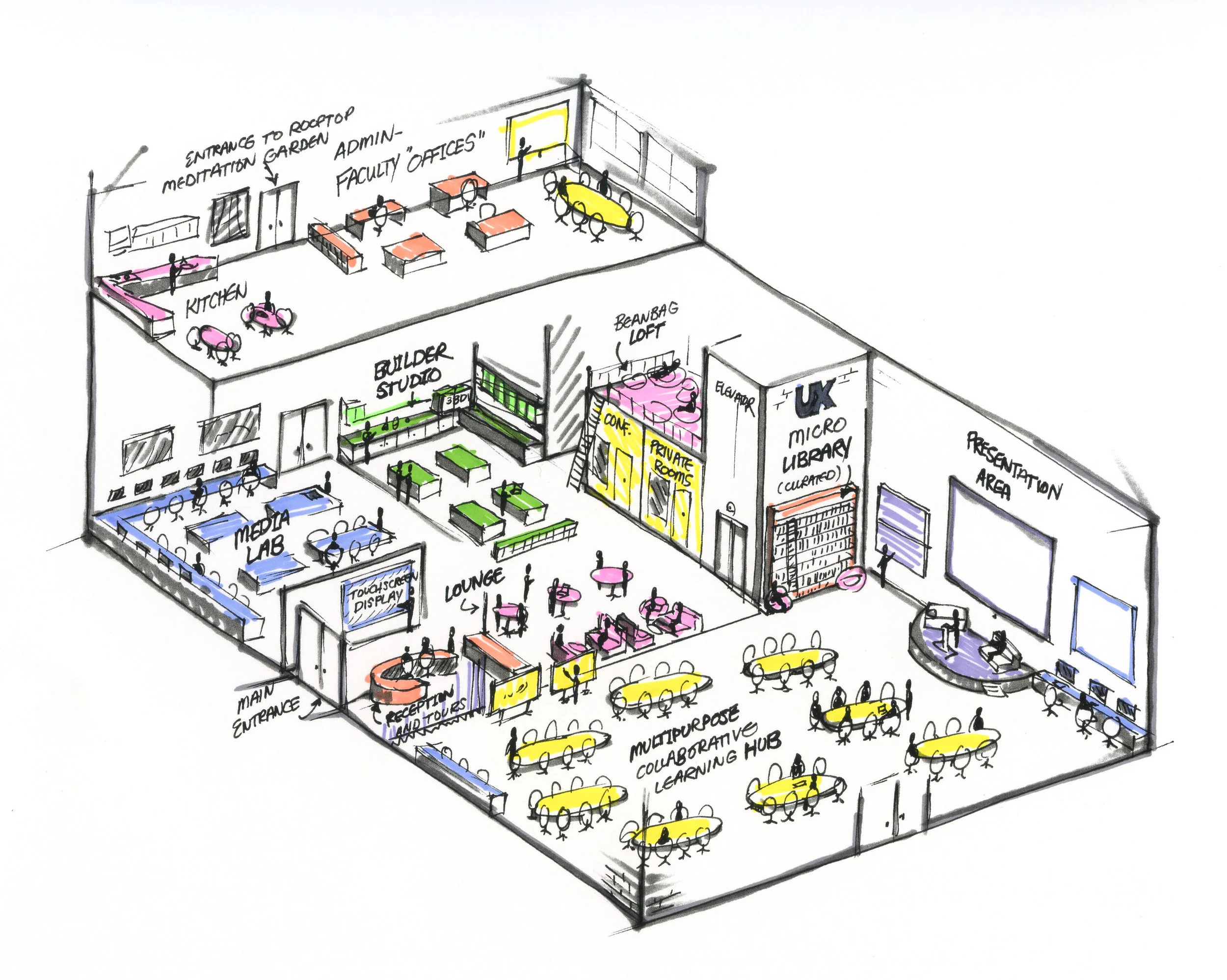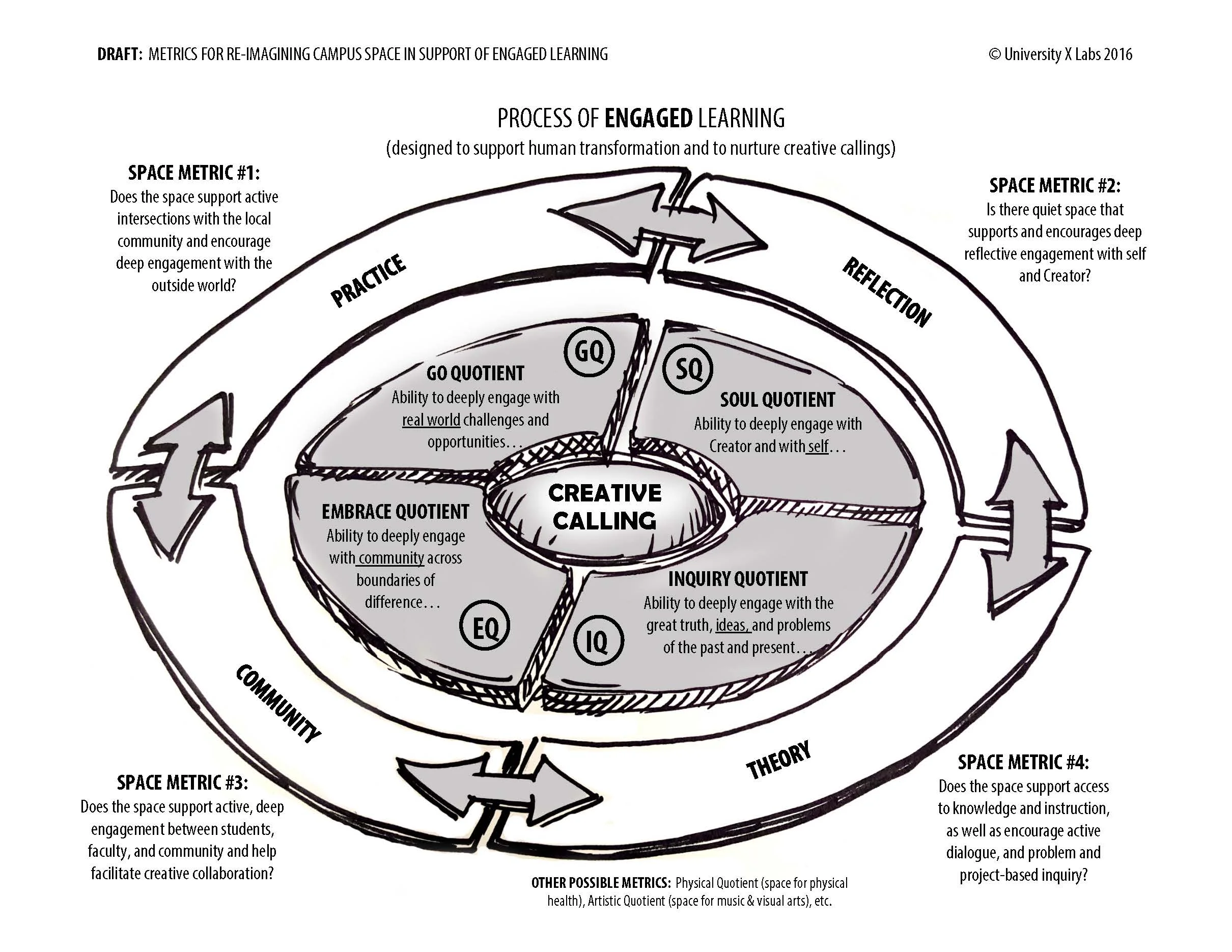Designed for Engagement (Part One): New Metrics for Reimagined Learning Spaces
What would it look if we were to design education spaces for a pedagogy of engaged learning –allowing for a continual movement between engagement with theory, community, practice, and reflection?
My university, in partnership with Steelcase, last year rolled out a new active learning classroom. This “flexible learning ecosystem” comes complete with Jetsons-styled rolling chairs in intense primary colors, detachable whiteboards, loads of tech tools, and chart of possible arrangements to suit different learning strategies. I am excited about the possibilities this space offers for messing with the physical layout of the classroom and playing with new technology. But this is not the kind of innovation I have in mind…
At the end of the day the “active learning classroom” is still the same basic classroom – just prettily repackaged and offering a bit more flexibility. As a professor I will still have my students for 50 minutes slots. We will be studying a subject like “intercultural communication” disconnected from other disciplines and in isolation from the actual diverse communities that surround the campus. And our primary activity will still be some form of talking. The active learning classroom remains a “cordoned off learning zone” as Bronner describes it - birthed out of a 19th century ideal of intentionally created isolation so as to foster total devotion to the life of the mind.
Research on the brain and the science of learning, however, have expanded significantly since the days when those lecture halls and classrooms were designed. Our brains are hard-wired for engagement, and I would challenge this idea that isolation from the outside world is the best way to cultivate the life of the mind.
What would it look like if we created learning spaces that were designed for engagement? Deep intellectual engagement with fundamental questions and ideas remains critical, but what if that intellectual engagement could intersect with deep engagement with other students, deep engagement with the city, and deep introspective and reflective engagement?
Learning, of course, doesn't require a traditional classroom. For example, for the next two weeks a cohort of students from my university will be in Kolkata, India working with Mother Theresa’s charity as part of the four-month CUI Around-the-World-Semester. Their typical day might include working at Mother’s House in the morning, visiting a temple as part of their fieldwork, retreating to a quiet space to journal and read The Ramayana in the late afternoon, then gathering early in the evening with professors and fellow students on the roof of their hostel to discuss the intersections between all of those dimensions of learning. This is the kind of deep engagement that creates flow and super-boosts learning. But how do we create that same kind of dynamic, praxis-based learning when students are not on a study abroad semester?
One course of action might be to take an IDEO-like, design-thinking approach to reimagining the campus and classroom. Back in 2015 I participated in the OpenIDEO Higher Ed challenge - an easy-to-access way to engage with the IDEO human-centered approach to innovation. One of the concepts I proposed was that of an urban micro campus with no more than 400 students as a lower-cost, higher-impact model. The space would be designed to support a symbiotic flow between the local community and the learning space – with students flowing into city and the city into the learning space.
This "learning-creating lab" would look something like an incubator or co-working space, but with a design laser-focused on student learning. A multipurpose and flexible "learning hub" would have doors that opened out into the city. A media lab and "builder studio" would allow students to move easily from discussing ideas to creating and testing prototypes. A central kitchen and dining area would encourage collaborative conversations in between more formal activities. And a rooftop garden would provide a quiet space for reflection and meditation.
Rather than building a cafeteria, dorms, sports facilities, chapel, or theater - the micro-campus would utilize the resources of the surrounding city. The basic idea is that the more infrastructure we create for students, the more they will be isolated from the "real world," and the less flow there will be between the campus and the city. Anchor learning spaces are essential, but the physical design of those spaces fundamentally shapes the pedagogy and learning that takes place inside those spaces.
(By the way, I do note that there are plenty of examples of universities that have small downtown campuses without dorms that are designed for commuting students. While this model of campus may have more engagement with the city than your typical suburban campus, the campus and classrooms aren't necessarily designed to facilitate the kind of flow that produces deep engaged learning outcomes).
One conviction I came away with after participating in the OpenIDEO Challenge was that, as we engage in a process of redesigning the campus and classroom to support engaged learning, we will need to create new metrics to evaluate the effectiveness of those learning spaces. For example, the praxis-oriented, engaged-learning model I advocate for is based on a process of flow between engagement with 1) theory, 2) community, 3) practice, and 4) reflection. The design of an engaged learning space would evaluate each of these dimensions of learning, something like this:
* Theoretical Engagement: Does the space support access to knowledge and instruction, as well as encourage active dialogue, and problem and project-based inquiry?
* Community Engagement: Does the space support active, deep engagement between students, faculty, and the local community and help facilitate creative collaboration?
* Engagement with Practice: Does the space support active intersections with the local city/environment, encouraging deep engagement with the outside world? Does it provide opportunity for ideas to be tested and for prototypes to be put into practice?
* Reflective Engagement: Is there quiet space that supports and encourages deep reflective engagement with self and the spiritual?
* Integrative Engagement: Does the space support a process of flow between these four areas of engagement?
You can see these metrics sketched out in a chart below....
It is important to note that there are already companies and organizations experimenting with new ways of imagining our physical spaces to facilitate creativity, collaboration, and transformative learning that could help inform our higher ed projects. For part "B" of this post I'll describe one such space - the "treehouse for creatives" headquarters of the Great Company in Los Angeles...
The Urban Micro Campus - sketch by Dan Waite
A Learning-Creating Studio
Metrics for reimagining campus space in support of engaged learning (draft)



